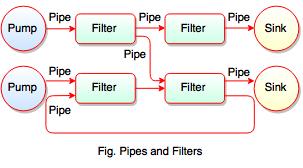Data Flow Architecture
- Data Flow Architecture is transformed input data by a series of computational or manipulative components into output data.
- It is a computer architecture which do not have a program counter and therefore the execution is unpredictable which means behavior is indeterministic.
- Data flow architecture is a part of Von-neumann model of computation which consists of a single program counter, sequential execution and control flow which determines fetch, execution, commit order.
- This architecture has been successfully implemented.
- Data flow architecture reduces development time and can move easily between design and implementation.
- It has main objective is to achieve the qualities of reuse and modifiability.
- In data flow architecture, the data can be flow in the graph topology with cycles or in a linear structure without cycles.
There are three types of execution sequences between modules:
1. Batch Sequential
2. Pipe and Filter
3. Process Control
1. Batch Sequential
- Batch sequential compilation was regarded as a sequential process in 1970.
- In Batch sequential, separate programs are executed in order and the data is passed as an aggregate from one program to the next.
- It is a classical data processing model.

The above diagram shows the flow of batch sequential architecture. It provides simpler divisions on subsystems and each subsystem can be an independent program working on input data and produces output data.
- The main disadvantage of batch sequential architecture is that, it does not provide concurrency and interactive interface. It provides high latency and low throughput.
2. Pipe and Filter
What is meant by Pipe?- Pipe is a connector which passes the data from one filter to the next.
- Pipe is a directional stream of data implemented by a data buffer to store all data, until the next filter has time to process it.
- It transfers the data from one data source to one data sink.
- Pipes are the stateless data stream.

The above figure shows the pipe-filter sequence. All filters are the processes that run at the same time, it means that they can run as different threads, coroutines or be located on different machines entirely.
Each pipe is connected to a filter and has its own role in the function of the filter. The filters are robust where pipes can be added and removed at runtime.
Filter reads the data from its input pipes and performs its function on this data and places the result on all output pipes. If there is insufficient data in the input pipes, the filter simply waits.
What are the Filters?- Filter is a component.
- It has interfaces from which a set of inputs can flow in and a set of outputs can flow out.
- It transforms and refines input data.
- Filters are the independent entities.
There are two strategies to construct a filter:
1. Active Filter
2. Passive Filter
1. Active filter derives the data flow on the pipes.
2. Passive filter is driven by the data flow on the pipes.
- Filter does not share state with other filters.
- They don't know the identity to upstream and downstream filters.
- Filters are implemented by separate threads. These may be either hardware or software threads or coroutines.
Advantages of Pipes and Filters- Pipe-filter provides concurrency and high throughput for excessive data processing.
- It simplifies the system maintenance and provides reusability.
- It has low coupling between filters and flexibility by supporting both sequential and parallel execution.
Disadvantages of Pipe and Filter- Pipe and Filter are not suitable for dynamic interactions.
- It needs low common denominator for transmission of data in ASCII format.
- It is difficult to configure Pipe-filter architecture dynamically.
3. Process Control
- Process Control Architecture is a type of Data Flow Architecture, where data is neither batch sequential nor pipe stream.
- In process control architecture, the flow of data comes from a set of variables which controls the execution of process.
- This architecture decomposes the entire system into subsystems or modules and connects them.
- Process control architecture is suitable in the embedded system software design, where the system is manipulated by process control variable data and in the Real time system software, process control architecture is used to control automobile anti-lock brakes, nuclear power plants etc.
- This architecture is applicable for car-cruise control and building temperature control system.

